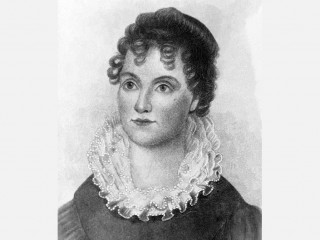
Hannah Hoes Van Buren biography
Date of birth : 1783-03-18
Date of death : 1819-02-05
Birthplace : Kinderhook, New York, U.S.
Nationality : American
Category : Famous Figures
Last modified : 2010-08-10
Credited as : First lady of the United States, wife of the US President Martin Van Buren,
0 votes so far
The historical record on the life of the wife of the country's eighth president is slim. Hannah Hoes Van Buren died eighteen years before her husband achieved the nation's highest office, and there is no mention of her in Martin Van Buren's autobiography. (Too much ought not to be read into that fact, as it was considered coarse and disgraceful for an early nineteenth-century gentleman to make public reference to a woman.) There are, however, a few surviving clues to her personality, and these indicate her brief life was one of relative contentment and piety.
Married Martin Van Buren(1837-1841)
Hannah Hoes and Martin Van Buren both were raised in Kinderhook, New York, a small community of Dutch origins along the Hudson River in Columbia County. The two were cousins (Martin Van Buren's mother Maria was a Hoes) and had known each other since childhood. Van Buren, who came from a large family with modest beginnings (his father was an inn and tavern keeper whose patrons included government figures traveling between New York and Albany), wanted to set himself up as a successful lawyer before marrying. After apprenticing as a law clerk for five years, Van Buren moved for a year to the bustling city of New York, population 60,000, where he continued to study and eventually passed the state bar. He returned to Kinderhook around 1803 and opened his law practice intending to represent the local small farmers and merchants rather than the wealthy landowners.
The Van Burens were married in Catskill, New York, during the winter of 1807, one month shy of Hannah's twenty-fourth birthday. That year, while still living in Kinderhook, Hannah bore a son, Abraham. The following year the couple moved to the nearby town of Hudson, where Van Buren served as county surrogate until 1813, when he was elected to the state senate. Two more sons, John (1810) and Martin (1812), followed; a third son did not survive infancy.
In 1816 the household moved to Albany, the state capital. Van Buren had won the election for New York attorney general in 1815. While in Albany, Hannah gave birth to another son, Smith, in 1817. But her health began to fail, and within two years, at age thirty-five and after nearly twelve years of marriage, Hannah succumbed to tuberculosis. Her sons were raised by a number of relatives. Her husband never remarried.
An Ornament of the Faith
Short-lived though it was, the marriage seems to have been happy. Hannah was remembered by a niece for "her loving, gentle disposition" as well as "her modest, even timid manner." Shy though she may have appeared, Hannah's personal letters reflect contentment and an active social life, as befitted not only a politician's wife but the wife of a man with a large number of relatives with a penchant for making frequent visits. It is very likely they were impressed with their self-made cousin, who had been too poor to attend college but had quickly developed a taste for finery. A member of a Dutch Reformed congregation, Hannah is recorded in some church documents as being a devout worshiper and committed to church activities. Upon her death the local paper, the Albany Argus, referred to her as "an ornament of the Christian faith."
Not until Van Buren won the White House -after serving as U.S. senator, New York State governor, secretary of state under Andrew Jackson, minister to England, and vice president- did the four Van Buren sons live together again with their father. Abraham, the eldest son, worked for Van Buren in the White House as the president's private secretary. Abraham's wife, Angelica Singleton Van Buren, took over most of the responsibilities of First Lady. Singleton was from a prominent Virginia family accustomed to the protocols of socializing and had been introduced to her husband by the head of Washington society, Dolley Madison, who also provided her skill and experience as hostess to the Van Buren presidency.
For the lawyer from Kinderhook, the presidency lasted only one term, and a tumultuous presidency it was. Van Buren had inherited from his predecessor Andrew Jackson a nation on the brink of economic disaster and had the bad luck of sitting as head of state during the country's worst depression, which he did little to ameliorate. He also presided over the country during the enactment of the so-called Trail of Tears, a campaign initiated by Jackson and continued to its lamentable end by Van Buren; this action was the forced removal of Native Americans from their lands. In his continued reluctance toward bold leadership, Van Buren opposed statehood for Texas, fearing annexation might tip the balance of free and slave states. In foreign affairs he fared no better and was humiliated by England, when a U.S. ship supplying arms to Canadian rebels was captured and destroyed. The man who had once been known as "The Red Fox" in acknowledgment of his cunning political skills was now being referred to as "Martin Van Ruin." After he lost his bid for a second term, Van Buren traveled through Europe before returning to his childhood home and purchasing an estate there. Hannah Hoes Van Buren and Martin Van Buren are buried in Kinderhook, New York.
















